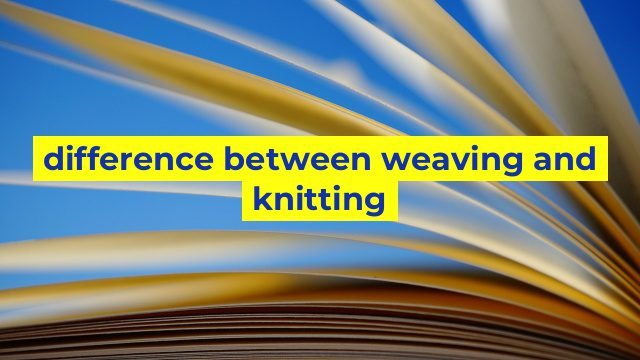The Difference Between Weaving and Knitting
When it comes to creating fabrics, there are two primary techniques used: weaving and knitting. Both processes involve interlocking threads or yarns to create a textile, but they differ in how the strands are manipulated. Here, we explore the similarities and differences between weaving and knitting.
Weaving
Weaving involves interlacing two sets of yarn or thread, the warp, and the weft. The warp consists of the lengthwise threads that are stretched out on the loom before weaving starts, while the weft, which runs perpendicular to the warp, is woven in and out of the warp threads.
During the weaving process, the weft thread creates an over-under pattern that locks the warp threads in place. This creates a stable and sturdy fabric that can be used for many different applications, such as clothing, rugs, and blankets.
Knitting
Knitting, on the other hand, involves creating loops of yarn or thread, which are then linked together to form a textile. This process can be done by hand, using knitting needles, or by machine.
The basic stitch in knitting is the knit stitch, where the knitter pulls a loop of yarn through an existing loop on the knitting needle. This creates a row of interlocking loops, with the loops in each row sitting on top of the loops in the previous row.
Knitting can be used to create a wide variety of fabrics, ranging from lightweight and stretchy to thick and cozy. It is commonly used to create articles of clothing, such as sweaters and socks.
Differences Between Weaving and Knitting
One of the main differences between weaving and knitting is the structure of the resulting fabric. Weaving produces a fabric that is tightly interlocked and stable, while knitting produces a fabric that is more flexible and stretchy.
Another difference is the equipment used in each process. Weaving requires a loom, which can be either hand-operated or automated. Knitting, on the other hand, can be done with just a pair of needles and a ball of yarn.
The techniques for weaving and knitting also differ. Weaving requires the weft to be passed over and under the warp threads in a specific pattern, while knitting involves creating loops of yarn that are linked together in a particular sequence.
In conclusion, while both weaving and knitting involve interlocking threads or yarns to create a textile, they differ in their resulting structure, equipment, and techniques. Each process has its own unique set of advantages and limitations, and the choice between the two will depend on the desired end product and the available resources.
Table difference between weaving and knitting
| Weaving | Knitting |
|---|---|
| Process of interlacing two sets of yarns or threads at right angles to each other to create a fabric. | Process of interlocking loops of yarns or threads in a series to create a fabric. |
| Requires a loom and a shuttle or other device to interlace the yarns or threads. | Does not require any special equipment – can be done by hand or with a machine. |
| Produces a stable, non-stretchy fabric with a right and wrong side. | Produces a stretchy fabric with no right or wrong side. |
| Multiple colors or patterns can be incorporated by using different colored yarns or threads. | Multiple colors or patterns can be incorporated by changing the yarns or threads being used. |
| Typically used to make fabrics like rugs, tapestries, and traditional dress. | Typically used to make fabrics like sweaters, scarves, and hats. |

